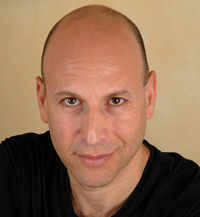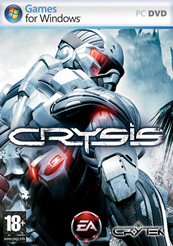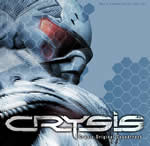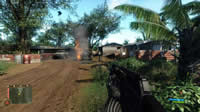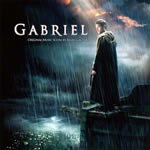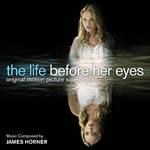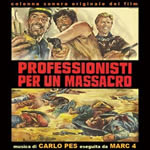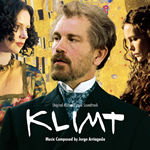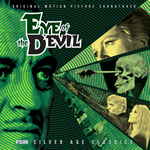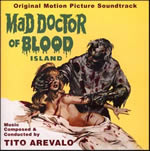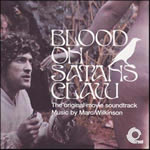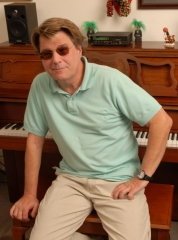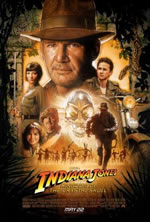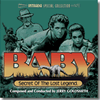 |
Soundtrax: Episode 2008-8
April 8, 2008
By Randall D. Larson
A Crysis On His Hands
The Video Game Music of Inon ZurThis week we interview game composer extraordinaire Inon Zur, who discusses his last composition, for the 1st/3rd person shooter game, Crysis. We review Scott Glasgow’s Bone Dry, James Horner’s poignant The Life Before Her Eyes, Philip Glass’ Animals in Love, Nathan Barr’s compelling ghost story, Shutter, the world premiere release of Carlo Pes’ tuneful Italian Western score, Professionisti Per Un Massacro, Atli Örvarsson’s Vantage Point, MSM’s latest releases Klimt and Trigger Man/The Roost, and a trio of wonderful low budget horror scores from decades past: FSM’s obscure horror find, Eye of the Devil, Philippine composer Tito Arevalo’s music for Mad Doctor of Blood Island, and Mark Wilkinson’s eloquent British horror music for Blood on Satan’s Claw. He also proffer news from around the world, and have a listen to what French composer Rene-Marc Bini had to say about his score for the potent home invasion thriller, Ils (Them), on the DVD extras.
Inon Zur Interview: Inon Zur
Inon Zur is recognized as one of the most critically acclaimed “A” list composers of music for games, whose emotionally charged music gives his gamescores an epic quality quite often the equal of Hollywood’s biggest blockbusters. Inon's music features in numerous blockbuster video game titles including, Warhammer 40,000 Dawn of War: Soulstorm, EverQuest II: Rise of Kunark, Company of Heroes: Opposing Fronts, Naruto: Rise of a Ninja, Lineage II: Chronicle V: Oath of Blood, Pirates of the Caribbean: Dead Man's Chest, Prince of Persia The Two Thrones, Men of Valor, Shadow Ops: Red Mercury, Syberia II, Champions of Norrath: Realms of EverQuest, SOCOM II: U.S. NAVY SEALS, Icewind Dale II, and Baldur's Gate II: Throne of Bhaal. His powerful orchestral scores have been featured in promotional trailers for such feature films as The Spiderwick Chronicles, The Other Boleyn Girl, Fool's Gold, Harry Potter and The Order of the Phoenix, Kingdom of Heaven, The New World, The Pacifier, Fantastic Four, The Hitchhiker's Guide to the Galaxy, and Annapolis. He also scored the new original CBS webisode series Ghost Whisperer: The Other Side, based on the successful CBS-TV series starring Jennifer Love Hewitt only told from the ghosts' point of view.
Zur is a graduate of the Music Academy of Tel Aviv in Israel and moved to Los Angeles to study music at the Dick Grove School of Music and UCLA where he studied under such luminaries as Jack Smalley, Alan Ferguson, and Henry Mancini.
Among Zur’s most recent gamescores is that for Crysis, the next-generation PC first-person shooter developed by Crytek and published by Electronic Arts. Recorded with the Northwest Sinfonia Orchestra in Seattle, Zur’s music for Crysis features sweeping themes, immersive setup pieces, intense action music, and "otherworldly" musical soundscapes performed by the orchestra to invoke the alien influences in the game.
"Inon’s ability to describe a complex situation through music is uncanny," said Crytek Audio Director Joseph Zajonc. "He grasps human interaction and internal conflict and delivers musical support for these scenarios with sensitivity and assuredness in his compositions. Inon’s sense of orchestration and the sound palette he has developed for this title are integral to the feel and identity of Crysis."
Soundtrax interviewed Zur recently about this score and the overall state-of-the-art of video game music.
Q. How has music for video games evolved and developed over the last five or six years? What is most distinct about contemporary games music?
Inon Zur: There are several aspects pertaining to the development of music for games. First, game music is not in a detached bubble of its own, and therefore it is often influenced by other popular media like movies, TV, and other pop culture products. For example, if there is a very successful movie, some games will seem to go for the same look and sound, and in some cases I get requests like “try to get closer to the sound of ‘this and this’ soundtrack.”
The other aspect of the development of music for games is in relation to the vast improvement of computers and the increasing power and ability of all its components. This allows the developers both in visuals and audio much more freedom and flexibility when it comes to interactivity and realistic look and sound.
One more thing, and I think this is the one that creates some distinction between music for games and other media music, is the “originality aspect.” In today’s film music, most of the time the composer gets a “temp score” and he usually needs to stay pretty close to it throughout the movie. In today’s games not only are the games not temped, but with new, original franchises the producers are putting some serious efforts to “think out of the box” when it comes to music. This approach has brought some freshness to creating music for games in the past few years, and I’m very happy with this growing trend.
Q: What do you feel is most distinct about your music for Crysis? How does this score differ from your previous game scores?
Inon Zur: In Crysis I had to combine three elements in order to support the story: the American force element, the Korean side, and the Alien aspect. The combination of these three distinct characteristic styles brought a new kind of hybrid sound, one that is quite unique.
Also, the way that the Crysis score interacts within the game is very innovative. It was based on a special interactive system that was developed specifically for the game. These two factors ultimately bring to life a different kind of score, one that is embedded deeply into the game and very interactive.
Q: While it does have a recurring primary theme, as has been the hallmark of most of your prior game scores, your score for Crysis does seem dominated by a strong basis of nonthematic action music. How would you describe your approach toward propelling the game's severe energy with this music?
Inon Zur: Since Crysis is a total action game, I thought that the music should be almost unnoticeable on one hand, but on the other it should constantly help pump up the level of excitement and energy. I felt that overusing thematic material would draw too much attention to the score, and in games like Crysis that is undesirable. However, the music should have a strong impact on the dramatic action happening in the game. Therefore I have chosen to compose many cues putting the accent on the percussive elements and sound design aspects more than on the actual theme. This way, the energy is there but the music doesn’t draw too much attention.
Q: How did you chose to musically accentuate the various nuances of this game besides it's straightforward FPS gameplay - for example: the US and Korean militaries, the "alien" aspect, the game's various settings?
Inon Zur: It all depends on the story. We really tried to put some thinking behind the actual placement of each cue – and aimed to match the music very closely to the storyline. For example, if the main character in a scene was Korean, but he somehow interacted with Americans and in the background there was an alien threat, I tried to give the cue this kind of balance, so the Korean aspects would be more obvious and the other elements would be more in the background. When the picture changes and the aliens take center stage for example, the music changes and follows the scene.
Q: How do you enhance characters and their interactions in a game score? How does the music support drama and story developments in a game beyond energizing its 1st/3rd Person Shooter action?
Inon Zur: The music system is designed to support dramatic changes in the story and to follow closely what is happening literally second-by-second. This is made possible by a new sophisticated music engine, which is choosing the cue based on the dramatic development almost instantly. Each cue has three variations – ambient, medium intensity, and full-on battle. The cues are basically the same when it comes to tempo, structure or keys, but the elements are changing. This allows the system to cross-fade between the variations seamlessly based on the given action, and overall it feels almost like a movie score because of how close the music follows the dramatic events.
Q: How closely did you work with the producers and the game engine developers in developing your score and then integrating it with the technology of the gameplay?
Inon Zur: We worked together extremely closely. We discussed the music system prior to the actual composing stage, so when I started to engage myself in the composing process I already had a clear idea of how the music system would work. This helped me a lot to make artistic choices based on the given music system. I think that this is a great way to work, and only this kind of close collaboration can bring great results when it comes to interactivity in music for video games. This is the future of how we will work in game music.
Q: How long did you have to compose and record the Crysis score? How did your score evolve throughout this process?
Inon Zur: The entire project took about a year from start to finish, but the bulk of the work took about 5 months. Once I learned more and more about the game during those months I was able to come up with more ideas of how to enhance the different situations. Like with many games, the composer needs to get to know the project in detail during which time it often evolves during the process.
Q: How does the Crysis score integrate electronic music and the orchestral performance of the Northwest Sinfonia? What's the texture of the final mix?
Inon Zur: Again, it depends on the dramatic substance. For example, if the Americans are the main focus now, the more traditional military-style orchestral music comes into play; if the aliens are taking over, there are more electronic and sound design musical elements. I really tried to find some kind of coexistence between all the musical styles in the game, so electronic music and traditional music can reside together and create a unique fusion.
Q: How do you integrate music with the sound effects on a game like Crysis? How closely do you work with the game's sound developers in achieving a harmonic sound design for the project?
Inon Zur: I asked for the main sound effects for the scenes so I could learn what music would work best with it. The audio team was very helpful and supportive so I could test my musical ideas along with the main SFX and see how well they would work or coexist.
Q: In scoring something like the Pirates of the Caribbean: Legend of Jack Sparrow game of the Star Trek: Starfleet Command game, how have you proffered your own musical voice into the game and its needs while staying true to the sound of the movie scores that players are going to expect? Is scoring a game with a known source like this easier – or harder – for you as a composer?
Inon Zur: Actually, it is both. When you are being restricted to a certain style and sometimes even thematic materials, it is narrowing the array of musical choices, but by that it is also simplifying your job in a way. At the same time, you still need to maintain your touch and signature, and this is the more challenging part. Overall, I prefer to be given a more open avenue in composing, but I can do pretty well also with a given style.
Q: What's most rewarding for you as a games composer?
Inon Zur: The feedback from gamers. If they feel I helped the game and made their gaming experience more exciting– I feel I did my job.
Q: As games become more and more cinematic, while maintaining their uniqueness of the player's interaction and the diversity of the game's ongoing storyline, how will music continue to play a part in the games of the next five or ten years? How will developing technology affect what composers such as yourself are writing - and how you write it? Give us a glimpse into the future of game scoring as you see it.
Inon Zur: I think that the trend that started about five years ago as far as audio will just continue. Games are looking more and more impressive and entrancing, so music has to follow these standards and serve the games in the best way. Computers will have more and more power, so the possibility to come up with more realistic experiences, or totally out of the world ones will just get better and better. However, we always need to remember that it always starts and ends with a good story. When the story is not working the technique can’t fix it. But when the story is good, then great creative ideas and technical assets like putting the audio to work can just bring it to life in a big way.
For more information on Inon Zur and to sample some impressive soundbytes, visit: www.inonzur.com
Read my review of Zur’s Crysis soundtrack CD in the February 11th edition of Soundtrax: http://www.buysoundtrax.com/larsons_soundtrax_2_11_08.html
This Week’s Recommendations & Soundtrack Notes
Gabriel is a 2007 Australian fantasy film that tells the story of an archangel who fights to bring light back to purgatory – a place where darkness rules – and save the souls of the city's inhabitants. The debut of both director (Shane Abbess) and composer (Brian Cachia), the soundtrack has been issued on the composer’s own label, BCMuse. Cachia, who grew up playing in bands in Sydney and then developed a healthy experience in production and engineering before finding his way into composing for films, beginning with Gabriel. Cachia’s work has been described as “darkly passionate,” “heavily emotive,” and “submersive,” layering complexity with simplicity, “often using atmospheric tones that weave effortlessly through rich orchestrations.” Those are apt descriptions which suit his score for Gabriel very well. The score captures a modern, rock-based vibe but maintains an orchestral-styled atmosphere with electronic instruments. Because the story occurs in purgatory, Cachia brings this environment to life with an epic sensibility, emphasizing dark, Gothic tonalities and layered textures. A vocal choir and soloists performing individual angel voices lend a human element to the score’s sonic design. “Arch’s Death” is a splendid choral track, darkly Gothic and yet with the operatic soprano voice so well known from gothic metal; it’s a captivating sonic texture that draws resolutely towards an abrupt and very effective denouement. “Michael” contains a similar tonality, enhanced by a chorus of tom-tom drumming, while “Angel Eulogy” . “Sin Factory Battle” contains a riveting texture with its sampled choir and persuasive drumming. “Aftermath” is a poignant piano piece that wafts into distant peals of thunder. Other tracks, like “Funhouse” and “Revenge” betray their composer’s rock and roll backgrounds, heavy on electric guitar and staccato rhythms to build a high degree of energy. Echoes of indistinct solo guitar ring throughout “After the Storm” amidst a reverberating wash of synth atmospheres to become a plaintive, melancholic melody of desolation and regret. “Union of Souls” is an anthemic rock instrumental textured by eloquent strings and synths that becomes a heroic motif, ascending heavenward. “Accept the Dawn” rafts a cadence of growing atmosphere merging the heroic motif, the rhythmic drumming, strings and guitars, progressing to an absorbing climax, which is reprised in “Conclusion.” Gabriel was Cachia’s first score but certainly not his last; he went on to score the Supernatural thriller Shape for director Andrew Miles, which has been described as an “evocative and compelling journey through one man’s descent into the unknown,” and is also scoring the drama Bitter and Twisted for Christopher Weekes. Four of the tracks on the Gabriel CD contain brief dialog snippets; the 6-page trifold CD booklet contains notes about the score by Cachia and by director Shane Abbess.
www.bcmuse.com
Intrada has released Scott Glasgow’s score for Bone Dry, first-time director Brett A. Harte’s road thriller about a traveler confronted and pursued across the desert by an aberrant gunman. The score, by the composer of Chasing Ghosts and Hack! (both released by MovieScore Media), broods with wicked intentions and cruel apprehension, its percussive undercurrents echoing throughout the dry, windless landscape of desert desolation. On first listen, this may seem to be another hybrid, layered textural horror score, but on closer inspection one finds that there is a great deal of musical meat to be savored throughout the score, it’s is an musically inventive as it is effective in heightening the film’s sense of unease and furious energy. To give the score an authentic, if subliminal, aspect of the desert, Glasgow used the sounds of a plucked cactus as an instrumental color in the score – “a very plucky, delayed arpeggio sort of sound representing the desert,” as he describes it. The cactus sounds, scrapes, brushes, and other manipulata cactile can be heard throughout the score, especially in the deliberately horrific “Cactus Torture” which begins as sound design beneath reverbed pounding percussion and then opens up with deliberate, methodical, epic horn arpeggios that rage with aggression, enlivening the cue with a tremendous power. In addition to the ubiquitous sound of Caryophyllales Cactaceae, the score is also enhanced by the metallic sounds of rebounding knife-ends “boinging,” heartbeats, bass drums, and a recurring stinger crafted out of piano harmonics with the piano strings held by a finger to change the sound when the key is struck. “With these sounds I created a very special musical palette for Bone Dry on top of the many standard themes, such as the ‘family’ theme on piano or the ‘stalking’ chords in the strings…” Glasgow writes in the CD booklet. “There is a balance between pure thematic ideas and colorful textures throughout this whole score.” The score finds its center in this sonic texture and derives much of its power from the depth of its grain. The “Mysterious Stranger” is introduced with recurring measures of furtive strings punctuated by a somewhat carefree drum pattern, perhaps suggesting the stranger’s confidence and swagger. A sustained, strident tone from violins and synths emanates out of this motif, while retaining the percussion pattern, to evoke the stranger’s evident malevolence and power. “Abduction” is carried out with festering, tremolo violins chords, undulating in and back for a bar or two, then obscured by the strident violins chords of the previous cue before all subsides in an ascending wash of highly-echoed strings. “Needle” is a captivating atmospheric cue that takes on an unassuming tonal cadence until midway through, when it metamorphoses into brittle and bony atonal textures, slamming percussion, and distorted sonic abrasions, the music continuing to juxtapose the protagonist’s confidence in being able to escape the stranger, and his seeming inability to do so. The score concludes with an amazing 20-minute musical sequence, spaced across three interconnected cues, “Epiphany,” “Contrition,” and “Redemption.” Performed by the 50-piece FILMharmonic Orchestra Prague (which also performed the opening cue, “Pool”), these three stirring climactic movements eschew the score’s previous hybrid texture and in a profound way evoke the bare essence of the film’s emotional human drama via the pure power of the symphony orchestra, performing not melodies but, like the earlier portion of the score, through chord progressions and layers of tonality and rhythm. These three purely orchestral cues form a mini-score of their own (Glasgow hopes to someday expand them into a live symphonic piece), as all forms of temperament and tactics and time and generation are worn away and the final confrontation between the two characters are erodes down to a basic human struggle, and bringing the score full circle back to the essential tonalities of its opening movement. Powerful stuff. Intrada’s release includes an 8-page booklet contains noted by both director and composer.
James Horner has composed a poignant and evocative score for The Life Before Her Eyes (originally titled In Bloom), which opens next week in the US after a limited premiere in Canada and Korea last Fall. The film, which reunited the composer with his director on House of Sand and Fog, has to do with a woman's survivor's guilt from a Columbine-like event twenty years ago that causes her present-day idyllic life to fall apart. Lakeshore has released the soundtrack album which contains a dozen score cues. The music is intimate and reflective, as one might surmise from the film’s storyline, but as it starts it’s rather innocuous. Favoring piano and soprano voice, the music wafts above the storyline and emphasizes through melodic fragments and lyrical acoustic tonalities the feelings harbored by a morose Uma Thurman and, as her younger self, the more innocent, or perhaps not yet unstained by tragedy, Evan Rachel Wood. But the music stays at a distance; perhaps intentionally. “Diana Gets Hit By a Car” (how’s that for a spoiler of a track title?) begins to generate a pretty melody but it, too, wafts into dissolution midway through. “The Memorial – The Laying of Flowers” progresses through multiple layers of strings over piano into a powerful cue, accentuated by an imposing synth sound, rumbling in like something from the Klingon battle in Star Trek II, as unhappy memories punctuate the occasion. This tonality resurfaces in “Two Worlds: The Past and the Future,” where it offsets the beauty of Horner’s uncredited singer and piano (performed by the composer) with the recurring insistence of unbid memories. The score concludes with a pervasive 12-minute composition, “Young Diana’s Future – A Future That Could Have Been…” which is every bit a poignant as its title might imply. Here, the unresolved elements of earlier cues are extended and extrapolated into an extended suite that resolves them in a carefully sustained and very sensitive manner. At exactly the halfway point, that Klingon sound exudes anew and the female voice blossoms in beautifully and profoundly, filled with all the innocence and wonder and bright hope that the event of Diana’s youth stole from her, showering the music with an effervescence of buoyant confidence. It’s the music of what could have been – what should have been – and it provides, perhaps in a way not unlike Atonement did for its primary characters, the future that young Diana lost. Musically, this is an exceedingly affecting cue and beautifully captures the film’s sense of loss, guilt, hopelessness – and the resolve of being able to regain a bit of that youthful optimism in the remembrance of it.
Orange Mountain Music has released Philip Glass’s latest score, for the French documentary, Animals in Love. The music is a little less cerebral than that Glass wrote for Anima Mundi, his 1992 wildlife documentary score for Koyaanisqatsi director Godfrey Reggio, but then the subject matter is a lot less cerebral as well. We’re dealing with animal emotions, after all, and the affection with which some of them hold other members of their species. Glass’ approach is recognizably Glass – rhythm and minimalism are the order of the day, with a progression and development suitable to the film’s 82-minute succession of relatively unrelated images centering around the theme of family-building in nature. First-time director Laurent Charbonnier (he was the cinematographer of Winged Migration) has put an assortment of beautifully-filmed shots together showing animals in various stages of courtship, copulation, nest-building, and brood-raising. Like Winged Migration, there is very little narration and such that there is in the French version serves only to open and close the film with vague metaphysics ("the molecules of love are the same in man and beast,” Cécile de France intones poetically), which means that the music is required to sustain all of the continuity of the visual montage. Where this isn’t possible due to the influx of so many unspoken images, music at least sustains a sense of motion and rhythm to the proceedings – two things that Glass does impeccably well. His music is effective and works wonderfully in giving these sequences a sense of space, of rhythm (especially when the creatures are taking a post-coital respite), and the music links diverse scenes to give the show a sense of continuity. Some of the visual elements inevitably encourage a slight degree of cuteness, which Glass serves perhaps begrudgingly in tracks like “The Bath” (featuring a very nice marimba riff), “The Kangaroos,” with a wonderful little scherzo for piping winds and strings, or the unavoidably Bambiesque “The Birth of a Fawn” with its intricate flute melody wafting through the omnipresent violin rhythms. This may be one of the lighter and most lyrical cues Glass has yet composed. “The Battle” is far more testosterone-laden, with harsh plodding keyboards and faint marimba setting the stage for a battle between horns and strings and snare drum as male animals of various species battle rivals for females – the nature watering hole version of the singles bar vibe. “The Peacock and the Japanese Crane” returns us solidly to Godfrey Reggio territory with the kind of compelling, progressive rhythms and tonal development Glass favored in his –QATSI scores for Reggio. Glass nicely contrasts the sizes of crickets and cetaceans in the impressive “From Insects to Whales,” which surges oceanically while rustling with intricate snare rapping and fragile woodwind piping, the cue evokes both the close-up wriggling of insectile legs and feelers and the gentle undulations of great whales riding the Atlantic currents. The simple 8-note melody that opens and closes the film, with the taking flight and return of evidently engaged swans, bookends the score very nicely and serves to both introduce and resolve the primary rhythmic/melodic elements that go between.
Nathan Barr provides a rather lovely score for Shutter, the latest J-horror film remade by Hollywood, from the same producers who did so with The Grudge and The Ring. This one has to do with a newly married couple who discovers disturbing, ghostly images in photographs they develop after a tragic accident.
Released to iTunes by Lakeshore, the online soundtrack consists of 17 score tracks and the closing sung, “Good To Be” (which also bridges the “Making Love” score track) sung by the delectably-voiced Lisbeth Scott (an ethereal, Hollywood version of Edda dell’Orso whose vocal soloing has charmed the socks off of me on the scores for Munich, Passion of the Christ, The Lion, The Witch & The Wardrobe and others). Opening with the gentle tunesmithing of “Welcome to Tokyo,” a lovely melody for cello punctuated by the light beating of a frame drum. This appealing opening is quickly severed by “We Hit A Girl,” introduced by a dissonant variety of chaotically raging horns finally resolved with a downflourish of cymbal; after which the music continues with rather morose mysterioso for viola and/or cello as the aftermath of the accident proves to be even more disturbing than the incident itself. Barr maintains a pleasant level of interesting tonality to much of the score (“TGK,” “Making Love,” “Jane Visits TGK,” the latter featuring recurring striking violin figures beneath [sampled?] male chorus) which contrasts notably with the score’s eerier moments (“The Spirit Room,” the chaotic dissonance of the panic-inducing “Fly in the Eye,” and the doleful denouement of “Psych Ward,” in which Barr’s intricate piano arpeggios are washed aside in a cruel hi-end string and blaring electronic tonality that closes the score with a brutal stinger). A ghostly female voice hovers over the sustained string melodies of “The Argument,” the same vocal elements lend a subtle chill to tracks like “Visiting Murase” and “The Truth”, and yet they’re not used in a cliché’d manner, but rather serve to double the string melody and become an effective texture within the lyric of the cue. “Visiting Murase” segues into a nice bit of rhythmic violin interplay as it moves along, and then it moves into a dissonance of atonal atmospheres. Shutter is a pleasingly tonal ghost movie score that is more melodic and compelling than it is scary and dissonant; while it never hesitates to underline the more chilling moments when it needs to, Barr has allowed room for plenty of lighter charismatic melodies that ground the score in contemporary reality and, consequently, make the score’s darker elements all the more powerful.
The Vinilo label of Japan has released a full score album, licensed through GDM, of Carlo Pes’ enjoyable Italian Western score for Professionisti Per Un Massacro (Professionals for a Massacre, aka Red Blood Yellow Gold, 1967). Pes’ main theme is very likable, in the classic mold of Italian Western music with twanging guitar over bass piano notes, choir (I Cantori Moderni di Allessandroni), and rollicking snare drum. It’s not quite first tier Italian Western music, but it’s likable enough. Variants for harmonica, whistler, and more or less twangier guitars appear among the album’s 23 tracks (which also includes mono mixes of three tracks, and for those who just gotta have it, a karaoke version of the main theme. Pes’ suspense music is very organic – a wolfish ocarina, sharp sounding castanets, guitar, more low end piano, which effectively congeals into a potent mix of progressive sounds design. The music is performed by an ensemble called Marc 4 about which little seems to be is known, conducted by Armando Trovaioli, himself a quite admiral Italian Western scorer. Most of the tracks are either variations on the main theme or the suspense motif, although a cool modernesque banjo number, slightly reminiscent of Giombini’s tune from Sabata, lends a pleasing tonality. The release has no notes and tracks aren’t titles except in a few cases, but at 52:25 and 19 of its tracks in full stereo, this world premiere complete recording is well recommended.
Icelandic composer Atli Örvarsson is the latest find to grow into and out of the Media Ventures training ground (via Berklee), having contributed to Zimmer’s scores for The Holiday and Pirates 3, so it’s not surprising that his big action score for Vantage Point, Peter Travis’ Bruckheimerish thriller about an attempted presidential assassination witnessed, and told (Rashomon like), from several differing viewpoints, is strongly rhythm based and very much in the Zimmer/Media Ventures mold. The soundtrack album, released by Varese Sarabande, is a compelling work; rhythmic and hybrid in its texture, emphasizing low strings (bass and celli), live flutes (Chris Bleth), guitars and dulcimer, trumpet, and plenty of live percussion, with synths and samples making up the rest of the sound palette. A conventional enough approach for a contemporary action score, but Örvarsson’s rhythm base is solid, as is his integration of tonality and melody. While the score maintains its energetic thrust to accompany the action scenes, Örvarsson also provides an eloquent sonority for voice (Leyla Hoyle) that enrich the score with a strong emotive flavoring. There are moments of rare tenderness throughout the score (“Enrique and Veronica,” “Lewis and Anna,” “The President is Safe,” “Epilogue”) that match its more vigorous cadences, and the score carries a weight of import that gives the music a hefty dynamic both on and off the screen. Örvarsson’s choices of orchestration give the score a likable and intriguing texture, and the music retains a melody-based tonality and rhythm that is thoroughly enjoyable.
Chilean born but French-domiciled director Raoul Ruiz’s Klimt, a sensitive portrait of Austrian artist Gustav Klimt (as only John Malkovich could play him) whose lavish, sexual paintings came to symbolize the art nouveau style of the late 19th and early 20th century, is available online from MovieScore Media. The very classically-styled score by Jorge Arriagada (Our Lady of the Assassins, Le Temps retrouvé, Comedy of Innocence) attempts to invoke the period and aesthetics of 1900, and in so doing incorporates influences of such classical composers as Schoenberg, Mahler, Alban Berg, and Schubert. The result is a pleasing but often overly recognizable restructuring of familiar classical measures and melodies (i.e., the obvious Strauss waltz intonations that appear in “Monuments of Vienna”). Most of the music, frankly, doesn’t do a lot for me, but then to my admitted fault I haven’t got the patience for most classical music, which is why I was drawn to the dynamic immediacy of orchestral film music instead; however those with an inclination toward classical music, or this period thereof, should find much to enjoy as perhaps a bit of a nostalgic journey through 1900 Vienna and environs. “Evocation,” with its dramatic cimbalom plucking over strings, is perhaps the most cinematic track on the album, and creates a splendid sonority and melodic atmosphere that is much more to my liking (the cimbalom reappears in “The Primavesi's Ball,” where it becomes the lead instrument of a very interesting short waltz). The score features fully orchestral material, chamber pieces (“Bonbon Waltz”) and a number of solo piano works; it seems to evoke period and practice (i.e., Klimt’s paintings) more than character interaction, psychological drama, or situational dynamic; one exception is the poignant violin soliloquy, “Snow,” which is empowered by its sense of melancholy and reflection; another is the album closer, “Mirrors,” which lays out a similarly morose fabric of introspection for winds over massed strings.
More to my liking but still not completely enthralling is MSM’s release of Trigger Man and The Roost, two scores from Jeff Grace (Joshua, The Last Winter, both also released by MSM). Ti West’s Trigger Man is a 2007 potboiler about a trio of hunters who inexplicably become the hunted; Grace’s score is often brash and raucous, but he creates a strikingly eerie effect in “The Innocent” by putting an acoustic guitar and a solo violin through an echo delay to craft a minimalist but emotionally intense austerity. This same motif is heard under the Main Titles to strong effect. The album includes eight tracks from Trigger Man, and 13 from Grace’s score to West’s 2005 cult zombie hit, The Roost, which MSM had previously released as an online download. This score is also designed for a very small ensemble, here a string quartet” but Grace proves quite capable in using the small group to great effect, a lot of it, again, quite brash and dissonant. He creates an almost free-form mix of tonal and atonal elements that accompany scenes like “The Shed” with a potent bite of musical disturbiana. Windswept atmospheres inhabit “The Barn,” blowing to an inevitable electronic stinger; “The Roost” is delineated with a growing sustainment of violin patterns that culminate in diabolical figures over low, moaning strings. Sharp-edged and tremolo celli chords evoke “The Pitchfork,” while a comically chinsey 50‘s sci-fi organ-and-theremin theme invokes a late night horror movie TV host who figures in the movie’s intro/outro; one of the score’s more humorous moments. Tracks like “Arm Munch” (the year’s best cue title, by far) are more representative, with the stabbing, flailing, and furiously emerged virtuoso string quartet performance evoking plenty of potent terror across the film’s soundscape. There’s no melody in either of these scores; instead Grace has chosen to incorporate inelegance to derive a chilling and continually disturbing atmosphere that will leave viewers – and certainly listeners – squirming.
Eye of the Devil and Gary McFarland are not well remembered as either a film or a film composer, which is too bad, since McFarland’s score for this troubled 1966 horror film, starring David Niven, Deborah Kerr, Donald Pleasance, and Sharon Tate in a tale of devil worship, is quite a good one. Issued for the first time anywhere (a planned LP in 1966 was never issued) as FSM’s Silver Age Classic release for March, the soundtrack is rich in sublime melody and intricately carved musical textures that enhance the film’s sense of bittersweet nostalgia, emphasizing the film’s primary perspective as seen through the eyes of Kerr’s sympathetic wife character. In this respect, the score is essentially melancholic although manages to sustain a growing sense of unease in so following Kerr’s viewpoint. McFarland, a jazz composer whose accomplishments brought him to the recognition of the film’s producers, would score only one more film before an untimely death in 1971, accompanies the film’s witchcraft elements with wordless intonations from chorus, but these are not the ferociously chanted Ave Santani’s of The Omen; rather they are Mancini-esque jazz-styled choral elements, ominous but melodic and rather captivating. In tracks like “Int. Chateau Night/Jacques In Bed” a pounding tympani is added to the choral motif as it develops, giving it as stronger propulsion, while in “Procession” a cavalcade of tubular bells resounds around the choral figures. In “Arrow into Tree,” McFarland begins to disassemble his beautifully wrought orchestral measures and emphasize the more disturbing aspects of what Kerr discovers about her husband, which is that he must be sacrificed to appease the misfortunes of the family vineyard. The track brilliantly echoes the menace imposed by the arrival of warlock David Hemmings into the family estate and serves as an effective counterpoint to the gloomy charm of the score’s overall sensibility. The composer’s symphonic jazz background serves well in tracks like “The Grave in the Forest” in which McFarland progresses from mysterioso to fright to outright panic, embraced by rhythmic cadence of shouting horns, cymbal rapping, and galloping timpani, culminating in a huge orchestral denouement, and in “You Must Help Me,” which becomes a progressive musical conversation between winds and percussion, a spare ostinato that will develop with the addition of additional instruments and a more urgent velocity; it’s an approach that almost recalls elements of Goldsmith’s Planet of the Apes (not to mention Miles Davis’ Sketches of Spain, as the liner notes posit). “Nightmare” also develops from an austere opening into a mesmerizing murk of haunting orchestral patterns – the horns that resonate with fine clarity at 1:07 lend an especially provocative power to the cue, replicated by the introduction of chorus later in the cue (other chorale elements that appear in the film during this cue have been lost from the music masters). McFarland’s climactic tracks (“Parapet Parts 1 an 2”) continues the cadence developed in “You Must Help me” and drives it to its inevitable conclusion, with the death of David Niven’s sacrificial patriarch; the music emphasizes through a cadence of snare drum the relentless inevitability of his fate while also sharing Kerr’s horror toward it as well as her own urgency to escape. “Jacques and the Eye” returns us to the sublime melody of the main theme, here enhanced by chorus, reminding us that the influence of the witchcraft upon the estate remains, and, indeed, Jacques accepts his position as the next patriarch – some day to hold the same fate as Niven. The score ends with a powerful upsurge of acceptance and finality. McFarland’s all-jazz percussion music for the film’s trailer closes out the cd.
FSM has done history a service by preserving this score, which is well worth attention as a significant entry into the decade’s horror film scoring; while Hammer was dueling away with the pure Gothic splendor of its Frankenstein and Dracula franchises, AIP was dishing out splendid scores for Roger Corman’s Poe adaptations, and Amicus was developing its own little Gothic excursion into the anthology film – all notable efforts in any regard, here Gary McFarland was doing something similarly notable that otherwise would have been fairly well forgotten. John Bender’s illuminating historical notes place the film and its score in the proper context, and Lukas Kendall provides an effective track-by-track overview of the score.
Meanwhile, a few years later over in the Philippines, Manilla’s horror film boom of the late ‘60s was emerging into full swing with the release of The Mad Doctor of Blood Island (1969, aka on the reissue circuit Tomb Of The Living Dead and Grave Desires), second film of the “Blood” quadrilogy that began with 1968’s Brides of Blood and would spawn 1971’s Beast of Blood and 1972’s Brain of Blood; but Mad Doctor was the first to have an original film score (Bride used ill-fitting classical excerpts as a budget-saving measure). The Blood films, through their mixture of sex, gore, and jungle exotica in some surreal narrative packages have become cult favorites among exploitation and Asian horror cinema fans. The inaugural soundtrack release of Tim Ferrante’s new label Elysee Productions, the score to The Mad Doctor of Blood Island is classic horror music, quite potent on its own and it stands up well against the work that such notable Hollywood B-movie composers as Paul Dunlap, Ronald Stein and Les Baxter were doing at the same time. Composer Tito Arevalo began as an actor who worked in the Philippine film industry since the 1930s, moving into musical direction and composition in later decades. His last original film score was 1979; he died in 2000. Actually, with Mad Doctor of Blood Island you get three scores in one: the same music was used in Beast of Blood (oddly, rerecorded with a smaller ensemble) and Brain of Blood (actually made in the US, its score was tracked with Arevalo’s Mad Doctor music). Composed for orchestra enhanced with chorus for the Main Titles and a couple of Steiner-worthy native dance cues, the music has a slightly exotic edge while enhancing the film’s excitement and the danger of the zombies created by Blood Island’s resident mad scientist, Dr. Lorca. The score is a mixture of tracks scored to specific sequences and a bushelfull of tracks recorded wild and intended to fit into scenes as needed during editing, ranging from 20 seconds to more than 3 minutes. Track “Number 9,” for example, is terrific monster music, a raging, plodding aggression of horns over timpani, punctuated by electric guitar and shrieking woodwinds, as Hammeresque a sound as the Philippines may have ever produced. There are a number of excellent renditions of ferocious monster music that really enliven the score and give the film’s low-budget a big added value enhancement. “Number 12” serves up a deliciously furtive bit of apprehensivo. Arevalo’s doubling of his orchestra notes with electric guitar or bass in many of the tracks like “Number 27,” “Number 16,” and so on (the “wild” tracks were not named but only numbered) lends the music an interesting sound, while a tender winds-full love theme in “Number 21” gives solace to the film’s romantic interludes. A gentle “Finale” restores normality and rescue. Mad Doctor of Blood Island is a first rate horror score by any measure, and one that Elsee’s producer Tim Ferrante strove for two decades to bring to CD. The 8-page CD booklet discusses the history of the film, the soundtrack, and Arevalo’s place in the pantheon of internationally notable film composers.
www.elyseeproductions.com
And be sure to stop by and visit www.timferrante.com
For more details on this soundtrack, read a cool interview with Tim Ferrante about the making of the Blood Island soundtrack, at: www.kqek.com/exclusives/Exclusives_Ferrante_1.htm
Yet another obscure horror score to emerge onto CD recently is Marc Wilkinson’s music for the 1971 British film, Blood on Satan’s Claw (aka Satan’s Skin). Released last year on Trunk Records, which also was the first to issue Paul Giovanni’s original Wicker Man score on CD, the music is from a classic Tigon release directed by Peter Haggard in the midst of the golden age of British horror, and is often seen as a companion piece to the studio’s Witchfinder General. It, too, is a period fantasy about witchcraft in 17th Century England, although with tons more nudity in its satanic rituals than was depicted in that esteemed 1968 Vincent Price pic. Composer Marc Wilkinson, former director of the National Theatre who came to some prominence with his first film score, for Lindsay Anderson’s speculative drama If, starring Malcolm McDowell (and who served as a kind of technical mentor for Giovanni when he composed Wicker Man), has scored Blood on Satan’s Score with a melodic fusion of folk melody and eerie tonal atmospheres using a fairly standard symphony orchestration enhanced by prominent use of cimbalom and ondes martenot. The Eastern European cimbalom, remaining mostly in a supportive role, gives the score a very pungent (as Wilkinson puts it in his CD liner notes) and percussive texture, while the martenot, a successor to the theremin, lends an eerie tonality to the film’s overall sardonic mood. “The descending chromatic scale which features throughout the music,” notes Wilkinson, “omits the perfect fifth… and therefore highlights the diminished fifth, which ever since the middle ages in Europe has been known as the Devil’s Interval.” This tritone has as a result found prominence in classical and popular music, and in horror scores such as this; while most audiences may not recognize this tritone for what it is, its tonal quality may well enhance a horror score’s subliminal measure of menace and the diabolic. Wilkinson’s score consists of a number of fairly short. “Peter’s Ride” carries a bit of the same carnivalistic attitude, rich with peril. Wilkinson’s main theme, added late in the process, has a folksongy quality to it and effectively suggests the film’s period and the less demonic facets of the storyline. Nicely heard in “Titles,” “Judge Drives Off,” “Mark Alone,” “Ralph Saves Margaret,” “Margaret Escapes,” and others, it consists of a gentle melody taken by flutes or ondes martenot. “Kathy’s Rape and Death” is a standout cue built around a calliope-like rhythm augmented by pulsating brass, swirling ondes martenot, skeletal percussion and piping winds, a stirring bit of musical accompaniment that, in its seeming circularity, becomes quite claustrophobic and mesmerizing, enhancing the terror of the scene it accompanies. “Ralph Bewitched” features a notable use of xylophone to punctuate its furtive measures; “Peter fights Devil, Severs Hand” is a terrific action cue with snarling trombone, rattling percussion, cyclonic swirls of violin, and raging brass. Eerie high-end violin lines over tuned timpani glissandi, punctuated by raps of cimbalom and a strange growling-like instrument I can’t identify, really emphasize the delirium of the character in “Rosalind’s madness.” Wilkinson’s dramatic 6:20 finale is a masterful progression of orchestral cadence enhanced by purposeful accents from the martenot and from percussion to create a striking climax that wafts between atmospherics and melody as if in a battle betwixt and between the good and the demonic, with the gentle melody of the main theme providing triumphant. An excellent score very nicely and significantly preserved. This would be a great score to hear live in concert. The 4-page CD booklet contains notes from Wilkinson, CD producer Jonny Trunk, and Michael Tyack of the folk/prog band Circulus, a fan of the score. Some of the tracks still include the track and take number on the front end of the cue.
www.trunkrecords.com.Film Score News
Prolific composer Christopher Young will receive the Richard Kirk Award for outstanding career achievement at BMI’s annual Film & Television Awards on Wednesday, May 21 in Los Angeles. Staged at the Beverly Wilshire Hotel, the black-tie, invitation-only dinner will also honor the composers of the past year's top-grossing films, top-rated prime-time network television series and highest-ranking cable network programs. BMI’s President & CEO Del Bryant, and BMI’s Vice President, Film/TV Relations, Doreen Ringer Ross, will host the event.
Named in honor of former BMI Vice President and film & television department founder Richard Kirk, the Richard Kirk Award is bestowed on composers who have made significant contributions to the realm of film and television. As the 2008 honoree, Christopher Young joins an elite list of peers that includes George S. Clinton, Harry Gregson-Williams, Jerry Goldsmith, Thomas Newman, Michael Kamen, Mark Mothersbaugh, Danny Elfman, Alan Menken, Mike Post, Lalo Schifrin and John Williams.
Award-winning composer Christopher Young has carved out his enviable niche in the upper pantheon of Hollywood composers with unusual speed and unerring flair. The UCLA Film School alumnus first turned heads with fiendish scores for horror and science fiction projects, and he proceeded to garner accolades for work on macabre and fantastical films including Hellraiser, its Saturn award-winning sequel and Species, along with BMI award-winners Ghost Rider, The Grudge and The Exorcism of Emily Rose. Young became a master of suspense, composing music for thrillers including Copycat and BMI honoree Entrapment, as well as dramatic and critical tours-de-force including Golden Globe nominee The Shipping News, Wonder Boys, Rounders and BMI award-winner Swordfish. He also fleshed out the haunting nuances and electrifying action sequences of box office gold Spiderman 3. The New Jersey native has also excelled in television composition, earning two Emmy nominations for telefilms Last Flight Out and Norma Jean & Marilyn. A dedicated mentor, Young has taught classes at USC, served as an advisor for the Sundance Institute Film Composers Lab and created an innovative residential development to house aspiring composers in Los Angeles. He describes his progressive two-pronged approach to composition as the exploration of the contemporary music’s abstract ideas and the infinite pursuit of “the great American tune.”
The ceremony will salute BMI's Emmy-winning composers from the past year. BMI will also present the Classic Contribution Award to Peter Golub in recognition of his progressive direction of the Sundance Institute Film Composers Lab for the past ten years. An accomplished composer of film, theatre, ballet and concert works, Golub is a natural fit for the lab, which aims to enhance the role of music in independent film. Universally acknowledged as an unparalleled apprenticeship for the next generation of composing elite, the workshop has invaluably benefited from Golub’s creative intuition and steady guidance.
Brian Tyler will follow up his intense score for The Fast and the Furious: Tokyo Drift with new music for the fourth film in the series. The film is yet untitled but is scheduled to hit theaters on June 5 next year, with Vin Diesel returning as the main star, accompanied by Paul Walker and Michelle Rodriguez. Brian Tyler is also attached to The Killing Room, a thriller about four people who take part in a psychological research study which turns out to be a terrifying classified experiment. Peter Stormare, Chloë Sevigny, and Timothy Hutton star in the film which is directed by Jonathan Liebesman, for whom Tyler previously worked on Darkness Falls. Tyler is also slated to score big budget action spectacle Dragonball. –via upcomingfilmscores.com
England’s BAFTA Television Craft Award nominations have been announced and the following are the nominations for TV music: Boy A (Paddy Cunneen), Cranford (Carl Davis), Doctor Who (Murray Gold), and Capturing Mary (Adrian Johnston). The British Academy Television Craft Awards will take place on Sunday 11 May at London's Dorchester Hotel. See: www.bafta.org/awards/television-craft/
Harry Gregson-Williams is going to score his sixth film directed by Tony Scott: the remake of the 1974 subway hijacking drama The Taking of Pelham 123. Slated for a 2009 summer release, the new version stars Denzel Washington and John Travolta and is scripted by David Koepp. The 1974 version of the film featured a strikingly original twelve-tone funk score by David Shire. Harry Gregson-Williams is also attached to Jerry Bruckheimer's action adventure G-Force, the X-Men spin-off Wolverine, and Dan Ireland's drama Jolene. – via upcomingfilmscores.comMarco Beltrami will score a film for Bertrand Tavernier next month, entitled Into the Electric Mist, a detective thriller starring Tommy Lee Jones, based on the James Lee Burke novel.
David Julyan will follow up his acclaimed dark orchestral score for 2005’s horror hit The Descent with new music for the sequel, The Descent 2. Written and directed by the editor of the first film, Jon Harris (who is also editing Eden Lake, another upcoming feature that Julyan is scoring), thesequel reportedly continues the story where the first movie ended. David Julyan is also attached to a film called The Daisy Chain, an Irish thriller starring Samantha Morton. –via upcomingfilmscores.com
Mychael Danna will score Stone of Destiny for director Charles Martin Smith, who previously worked with Danna on The Snow Walker in 2003. The film tells the story of Ian Hamilton, a Scottish nationalist who wanted to bring the Stone of Scone back to Scotland from England in the 1950s. Danna is also teaming up again with Canadian auteur Atom Egoyan to score Adoration, a drama starring Scott Speedman, Rachel Blanchard and Kenneth Welsh. In addition to these two films, Danna is also attached to The Time Traveler’s Wife and Passchendaele, and is co-writing the scores for Lakeview Terrace and The Imaginarium of Doctor Parnassus with his brother, Jeff Danna. – via filmscoreweekly.com
Joel Goldsmith is doing the music for Stone's War, an action thriller written and directed by Finnish filmmaker Marko Mäkilaakso, as well as Stargate: Continuum, a Stargate movie coming out on DVD this summer, following Stargate: The Ark of Truth, which was released on March 11. Since the launch of the Stargate television franchise in 1997, Goldsmith has been the main composer of both Stargate SG-1 and Stargate: Atlantis. – via upcomingfilmscores.com
Soundtrack News
Speaking of Joel Goldsmith, his new independent label, Freeclyde, is releasing his score for this year's direct-to-video movie Stargate: The Ark Of Truth on April 18th. Recorded live with the Seattle Northwest Sinfonia, this CD underscores the conclusion of SG-1's struggle with the Ori, as well as its ongoing battle with the Replicators. More information and lots of entertainment can be found on Joel’s unassuming official web site at http://www.freeclyde.com/ .
Joeharnell.com presents the original television soundtrack recording to The Bionic Woman: Kill Oscar Parts 1 and 3 in loving memory of the great Joe Harnell. While the second part of Kill Oscar contained music composed by J.J Johnson, this release only contains music composed and conducted by Joe Harnell for the first and third parts. This release includes the complete scores to both episodes, including an alternate Main Title theme that ended up not being used in the series. In addition, original musical sound effects he produced for these episodes are also included. The Bionic Woman: Kill Oscar Parts 1 and 3 is an exclusive joeharnell.com release, professionally mastered, factory manufactured and limited to 1000 units. http://www.joeharnell.com/bionic_woman_v1_cd.html
John Williams’ score for Indiana Jones and the Kingdom of the Crystal Skull will be released on CD on May 20th, just a couple of days before the film hits screens worldwide. The score will be made available by Concord Records, a jazz, blues and classical label which previously released Gustavo Santaolalla’s Babel. Early reports suggest Williams has stuck closely to the style of the original scores, which Concord will reportedly re-release separately at a later date. The score is also the first to feature the brand new hi-tech keyboard instrument, the “Continuum Fingerboard,” a keyboard that pre-empts where the performer’s fingers will go using complex sensors. Although the device provided ambient sound for the likes of Superman Returns and Williams’ own War of the Worlds, Crystal Skull marks the first time it has been used as an instrument. – via musicfromthemovies.com
Among Digitmovie’s March 189th releases is the complete original motion picture score, for the first time in full stereo, for the 1968 cult movie Escalation, composed by Ennio Morricone. The film was directed by Roberto Faenza and starred Claudine Auger, Lino Capolicchio and Gabriele Ferzetti in a story about the son of a prominent Italian industrialist who enjoyed life as a London hippy while his father wants him to be introduced to the family business – by any means. Also in the March releases from Digitmovies are Carlo Rustichelli’s I Giganti Della Tessaglia (The giants of Thessaly), 8th volume in the label‘s series of vintage peblum film scores; Sante Maria Romitelli’s complete score for the 1969 Mario Bava giallo, Il Rosso Segno Della Follia (Hatchet for a Honeymoon), and the scores for two Italian sex comedies from the late 1960s, La Liceale / La Liceale Nella Classe Dei Ripetenti by Vittorio Pezzolla and Gianni Ferrio, respectively. The label is in the process of moving to a new web site and has temporarily taken up residence at http://www.digitmovies.com until the new site is done.
Intrada has released, in a 3000-copy limited edition, the complete score to Disney’s Baby: Secret Of The Lost Legend, composed by Jerry Goldsmith. The 1985 B.L. Norton dinosaur adventure, starring William Katt and Sean Young as paleontologists who discover a mother and baby brontosaurus in Africa and try to protect them from hunters who want to capture them, was rather hokey and really needed the kind of CGI they came up with eight years later to sell its concept. But Goldsmith anchors the score in a
majestic motif from which a cornucopia of action music plays out as needed. Score’s highlight is the propulsive 5/8 meter “Rescue” with its unrelenting ostinato under roaring brass. “When entire orchestra suddenly tacets for two bars, leaving percussion to carry thundering rhythm alone, listeners hear one of composer's most exciting riffs” says the label. The entire score is presented in stereo from Disney digital master elements. A generous array of color stills from studio vault plus notes from Jeff Bond complete the package.MovieScore Media has released their first jazz album with the soundtrack to Jellysmoke, a 2005 drama composed by NY-based pianist/composer Peter Calandra that also includes as a bonus his infectious score for Unknown Soldier, released by MSM earlier as an online soundtrack.
FSM is pressing a 2nd Edition of its big box set of Superman scores, with a release expected in late May. This will be an identical release to the first edition with the exception of a “2nd Edition” notation on the title page of the included book. The 8-cd box set contains music from all four Christopher Reeve Superman movies, composed by John Williams and, in movies 2-4, adapted by Ken Thorne and Alexander Courage, plus Ron Jones music for the 1988 animated series.
Lakeshore Records has released a songtrack album from Prom Night, the new remake of the 1980 slasher film. The album contains the usual assortment of metallish rock music seemingly apropos for modern day slasher movies, some good (Ben Taylor does a nice rock/electronic rendition of Argent’s “Time of the Season,” Mellowdrone’s shoegaze-ish “Oh My,” and This Will Destroy You’s crystal clear instrumental, “I Believe in Your Victory”), some bad (Mr. Me Innit’s abrasively obnoxious rap, “This Is All That We Know” and that of Consequence in “Callin’ Me – but then, all rap is bad to my ears anyway), much inconsequential. Also included is a nice version of Cindy Lauper’s “Time After Time” by Quietdrive – but it wasn’t in the film nor inspired by it, so I don’t quite get the association unless the original tune play in the film somewhere. Lakeshore says they do not plan to release an album of Paul Haslinger’s score for the film and there’s no word yet on whether or not a score CD is on the horizon from another label. Paul Zaza & Carl Zittrer’s electronic score from the 1980 film, out of print since its sole LP release in Japan, is reportedly being revived for CD release by Zaza.
Colosseum Records has released the score for Absurdistan, a slapstick allegorical comedy from Germany filmed in Azerbaijan, about a pair of childhood sweethearts whose desire to consummate their love seems thwarted by the absurd rules of their small village. The music is by Shigeru Umebayashi (House of Flying Daggers, Jet Li’s Fearless), Lars Löhn, and Tofiq Guliev.
Cinematic Sound is a three hour radio program dedicated to the music of film, television and video games. The show is hosted and produced by Erik Woods and is available On-Demand via Real Audio. A new segment dedicated to classic Hollywood film music has been launched on the site, called The Golden Age Film Music Re-recordings program, and features selections from new and classic re-recordings of classic Hollywood film music. Cinematic Sound also presents samples from new and forthcoming soundtrack recordings. Surf over to it at: www.geocities.com/cinematicsound/
Film Music on DVD
From Japan comes Kenji Kawai Concert 2007 - Cinema Symphony, a 2-disc concert DVD from Kenji Kawai's symphonic live at Yokohama on November 7, 2007. Includes selections from the films Innocence, Ghost In The Shell, Patlabor, Avalon, Death Note, A Battle Of Wits and more.
The mesmerizing French psychological horror film, Ils, which was released recently in the US under its American title, Them, contains a fascinating atmospheric and textural score by Rene-Marc Bini. Bookended by a pretty piano theme which suggests the pastoral landscape of Bucharest in which the film is set, the score quickly becomes darker and more intricately designed once the scene shifts to a countryside manor where the lead couple become the victims of a frightening home invasion by unseen predators. Bini uses an effective sound pallet of sustained tonality, minimalist piano (fragmentarily recalling the opening theme), creepy high wisps of synths and strings, throbbing percussion and burbling mixtures of sound design, low end piano beats, as well as allowing plenty of room for silence and the recurring ratchet sound made by one of the perps. It’s a mesmerizingly disturbing score which serves the film wonderfully.
The Region 1 DVD release, from Dark Sky Pictures, includes a 10-minute featurette about the score as one of three features on the DVD. Bini described in detail the creation of the score and how his approach evolved into a hybrid of manipulated acoustic sounds and electronically-conveyed textures. “The opening theme stands out because this is what the film calls for,” Bini explains. “The film itself is very different once you enter the house. The theme keeps you away from the film’s realism. The theme magnifies and evokes something different. The directors wanted to stay constantly focused on the fear of the characters. Anything thematic could distract or distance.”
Instead, Boni focused on music that would enhance the film’s sense of unease and scariness without calling attention to itself. “It’s more organic,” he explains. “It’s scary but it is not organized at all harmonically or melodically. It’s like a kind of magma, where lots of sounds get mixed up any old way. We opted for more effects and extra treatments that mess up the sounds even more.”
In some passages, Bini took the orchestra strings and manipulated them so that he got something that sounded like it came from a synthesizer, but yet had a sound unusually more familiar. “I love mixing classical instruments with non-classical instruments, and mix it all up with altered sounds, more modern, more synthetic,” Bini said. “I am interested in creating a different music every time, with different ingredients. Nothing pleases me more than being forced to use instruments I’m not familiar with.”
Samples of the score can be heard at the composer’s web site: www.renemarcbini.com
Game Music News
Sumthing Else Music Works, Inc., through its licensing relationship with Mistwalker, presents Blue Dragon Original Soundtrack. The 2-disc soundtrack album is now available at US retail outlets through Nile Rodgers’ Sumthing Else Music Works label www.sumthing.com and digital download service www.sumthingdigital.com and will also be released on iTunes.
Blue Dragon is created exclusively for the Xbox 360 by famed game producer Hironobu Sakaguchi of Mistwalker game studio. Featuring the character design of Akira Toriyama, who designed Dragon Ball Z, and music by Nobuo Uematsu, the composer for Final Fantasy, Blue Dragon is an epic role-playing game (RPG) centered on a young boy named Shu and several of his friends. These unlikely heroes possess the power to control phantom shadows that mirror the actions of their masters, giving Shu and his comrades miraculous strength and magical powers.
Randall Larson was for many years senior editor for Soundtrack Magazine, publisher of CinemaScore: The Film Music Journal, and a film music columnist for Cinefantastique magazine. A specialist on horror film music, he is the author of Musique Fantastique: A Survey of Film Music from the Fantastic Cinema and Music From the House of Hammer. He now reviews soundtracks for Music from the Movies, Cemetery Dance magazine, and writes for Film Music Magazine and others. For more information, see: www.myspace.com/larsonrdl
Randall can be contacted at soundtraxrdl@aol.com

